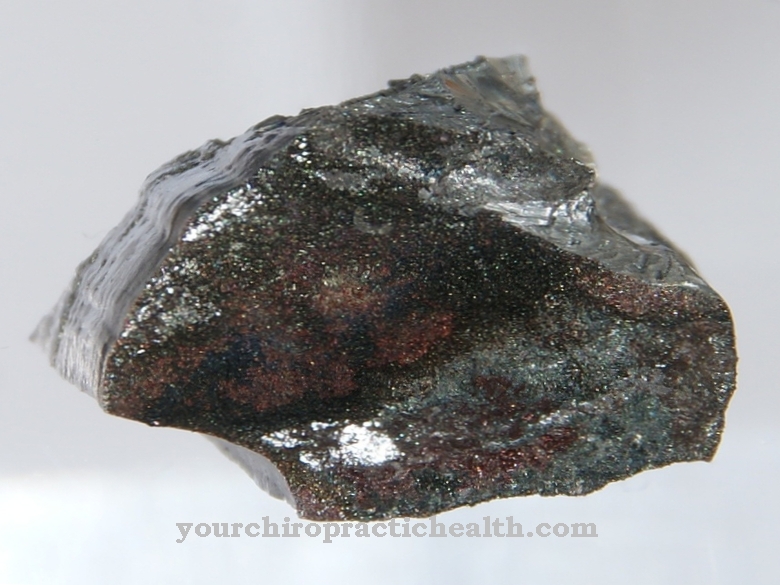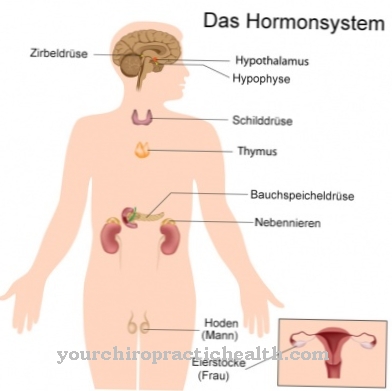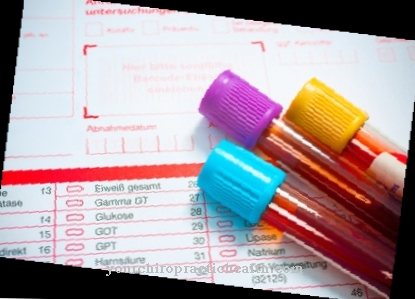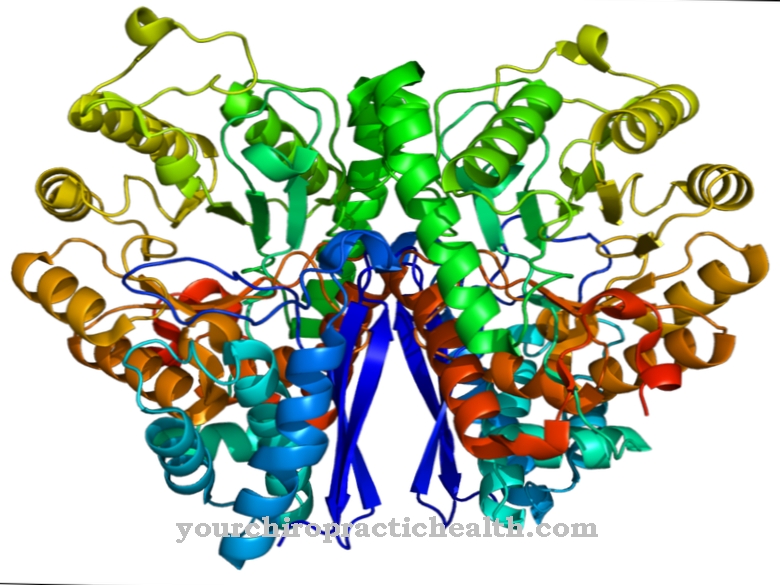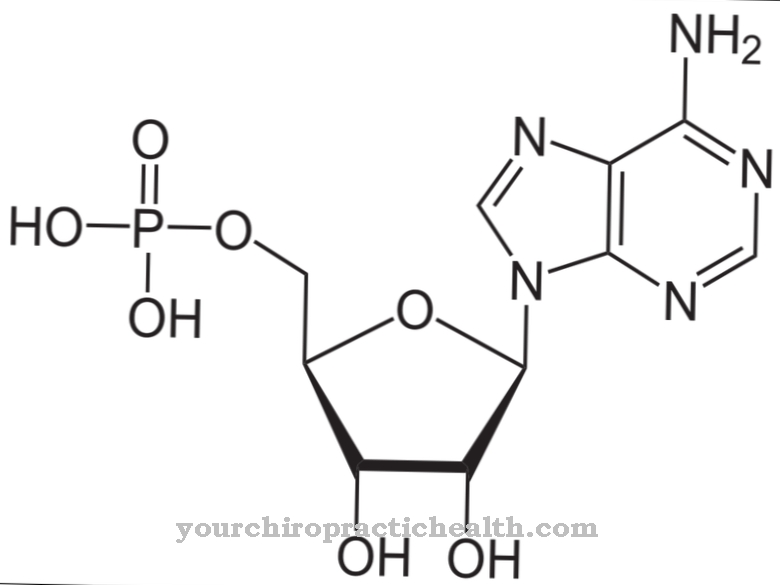Neuron-specific enolase - short NSE called - is a biocatalyst (enzyme) of the sugar metabolism.
It is present in the body in various cells such as the peripheral and central nervous system and in the tissue of organs. Increased NSE values in the blood and cerebrospinal fluid (cerebrospinal fluid) can be determined, especially in diseases. Therefore, cancer diagnostics uses the enzyme as an indicator of the presence of tumors.
What is Neuron Specific Enolase?
As a neuro-specific enolase (ENOG, NSE) is the medical / biochemical term for an enzyme that is responsible for the glucose metabolism in the body. The biocatalyst, also known as phosphopyruvate hydratase, occurs in three forms in the body, which have a similar mode of action and can even work together.
NSE is found in the nerve cells (neurons) of the brain and peripheral nervous system, in neuroendocrine tissue and also in cerebrospinal fluid. In many organs such as the thyroid gland, lungs, gastrointestinal tract and the lower urinary tract, it is particularly present in the Apud cells. They are located in the pancreas, gastrointestinal tract, bronchi, urinary organs and the cardiovascular system. Neuron-specific enolase controls glycolysis (sugar metabolism) in the body and can therefore also be detected in blood serum. In the blood, it serves as an indicator of the presence of various diseases and even cancer. It is used as a tumor marker in cancer diagnostics.
Function, effect & tasks
As a tumor marker, it has the task of determining the type of cancer present (small-cell carcinoma or non-small-cell carcinoma) and its size. This is done by determining the NSE content in the blood serum.
If it is elevated, it indicates the presence of a disease or tumor in the body. Cancer diagnosis uses the enzyme neuron-specific enolase primarily to differentiate benign cancer cells from malignant ones. Since the biocatalyst prevents the breakdown of glucose (glycolysis) under the influence of fluorides, the sugar levels can be determined in the laboratory. If the NSE value in the blood serum is increased, this can indicate the presence of a health disorder and, in extreme cases, even cancer. However, people with less serious complaints sometimes have increased NSE values.
If this is the case with a pregnant woman, neural tube damage in the child may be to blame for the deviation. In tumor diagnostics, the measurement of the concentration of neurospecific enolase is the third and final step after the microscopic detection of cancer cells and cancer tissue. The regular review of the NSE value carried out on cancer patients and other patients is used to control and evaluate the course of the disease and the success of the therapy.
A prognosis is also possible based on the values. Lower neuron-specific enolase values in the normal range after chemotherapy, for example, allow the conclusion that the treatment was successful in the patient. However, the determination of the enzyme concentration is not suitable for tumor search and cancer prophylaxis.
Education, occurrence, properties & optimal values
The neuron-specific enolase is - as the name suggests - formed in the neurons (nerve cells) of the brain and in the endocrine tissue. There are three Emolase groups in total: Alpha-Emolase is tissue non-specific, which means that it occurs in all types of body tissue. Beta-enolase, on the other hand, is only localized in muscle cells. Gamma enolase is mainly found in nerve tissue.
All enolase groups can also be detected in combinations. Alpha- / beta-enolase can be determined in addition to beta / beta-enolase in the striated muscles. Gamma / gamma enolase occurs alongside alpha / gamma enolase in the nerves. All three enolase groups have a similar biochemical reaction. To measure the NSE value, blood is drawn from the patient and analyzed in the laboratory using the immunoassay. The biologically active substance is identified via the antigen-antibody reaction. The very precise method even allows measurements of the smallest quantities. Depending on the commissioned laboratory and the measurement method chosen by it, the maximum NSE value in the blood serum is 10 or 12.5 micrograms / liter.
A limit value of 12.5 micrograms / l (adults) is often set. For small children under one year of age, the maximum enolase value is 25 micrograms / liter. All NSE values that exceed 4 micrograms should be viewed critically as they are an indication of the presence of a disease of the brain and nervous tissue. However, just a small increase in value is not a cause for concern. Since the enzyme is contained in high concentrations in red blood cells and platelets, a mistake during centrifugation can lead to an increase in the NSE value.
Diseases & Disorders
To find out if a patient who has had a serious accident has brain damage, blood is drawn 24 hours after the resuscitation and the NSE value is checked. A second blood sample and blood analysis are carried out after 48 hours.
If the NSE value has normalized after 72 hours (third blood sample), the doctor assumes that there is no permanent brain damage and that there is no further increase in the values. Elevated NSE values are found in the rare Creutzfeldt-Jakob disease, the human counterpart of BSE, which occurs mainly in cattle.
Brain injuries with intracerebral bleeding, meningitis, brain inflammation (encephalitis), cerebral infarctions and a brain disease that occurs in connection with multiple sclerosis (encephalomyelitis disseminata) cause the NSE values to rise above the normal range. The same applies to liver and lung diseases (pulmonary fibrosis, bronchopneumonia), circulatory and vascular diseases (stroke) and cancer (bronchial carcinoma, neuroblastoma, etc.).

